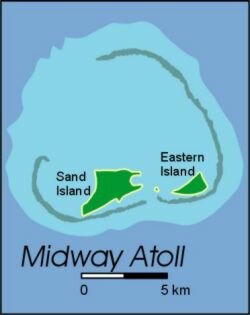Midway, the best known of the Northwestern Hawaiian Islands (NWHI), is a circular-shaped atoll with three small islets (Sand, Eastern, and Spit) on the southern end of a lagoon. While its land area is small, about 1,535 acres, the atoll has approximately 85,929 acres of reef area.

Captain N.C. Brooks of the Gambia sailed to the atoll in 1859. After Brooks, the United States annexed it as the first insular possession to be claimed outside the U.S. continent. People visited Midway during the late 1800s primarily to collect feathers and eggs. Through the early 1900s, the United States recognized this "stepping stone across the Pacific" as a critical link for round-the-world communications and as a stop over for Pan American seaplanes. During World War II, Midway became a major U.S. military base. The atoll was attacked twice, once on December 7, 1941, after the attack on Pearl Harbor, and again during the pivotal Battle of Midway, which turned the tide of the war in America's favor. The atoll was designated as the National Memorial to the Battle of Midway in 2000.
In 1996, the once strategic naval base was turned over to the U.S. Fish and Wildlife Service to be managed as Midway Atoll National Wildlife Refuge. A massive U.S. Navy clean up prior to their departure removed tons of debris, leaky fuel tanks, and lead paint, as well as rats. Today a fulltime Refuge staff administers a small visitors? program, cares for its wildlife, restores native plant life, and protects historic resources.
Nearly two million birds of 19 species nest on Midway. The atoll has the largest Laysan albatross colony in the world. Other birds include black-footed albatross, red-tailed tropicbirds, white terns, black and brown noddies, shearwaters, and Bonin petrels. One of the rarest visitors is the endangered short-tailed albatross.
Three-fourths of Midway's plant species were introductions. These include weeds, ornamental shrubs, exotic vegetables, and trees such as coconut palms and ironwood. Major efforts are underway to control alien species and restore native habitats. The waters abound with dolphins, monk seals, and green sea turtles. More than 250 species of fish live in its waters, including hapu?upu?u (the rare Hawaiian grouper), ulua (jack), kumu (goatfish), and sharks. Beyond the reefs are pelagic fishes such as tuna and marlin.
Despite 100 years of human impact, the reef at Midway is rich and diverse. Sixteen species of stony coral have been reported, and scientists believe there may be many more. Marine habitats, including spurs, grooves, and sand channels, are home to several algaes, seagrass meadows, urchins, bivalve clams, sponges and more.
|

